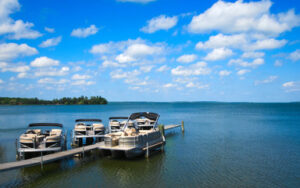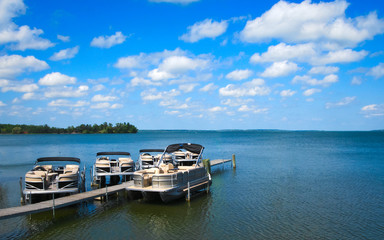Dock Lifts Charleston SC allow level loading and unloading without the need for ramps or inclines. They are mounted flush with the floor and have low-profile dock mounting, avoiding costly pit installation.
They have wheels that facilitate the rolling of loads for transport and positioning, and handrails or safety rails to ensure personnel safety. They also have a range of lifting capacities based on truck capacity and vertical lift travel.
Dock lifts are an efficient means of transferring cargo between vehicles and loading docks. However, like all industrial equipment, they must be carefully maintained to ensure the safety of workers using them. The most important thing to remember is that they should only be used by trained and qualified personnel. They must also be periodically inspected and tested according to the manufacturer’s recommendations. This will help avoid costly repairs and ensure that the equipment is operating as designed.
Several safety features can be added to dock levelers to further increase their safety. These include shims and toe guards. Shims are steel plates that can be placed under the frame structure to help level a pit-mounted dock leveler. Toe guards are a shield that is mounted flush to the side of a deck assembly to provide toe protection when the dock leveler is above dock level.
For additional safety, a dock lift may be equipped with automatic gates that close when the lift is elevated to prevent the risk of people falling between a truck and the building. These gates are typically activated when a vehicle moves over the lift at a slow speed. They also remain locked until the lift is lowered to ground level and the vehicle has stopped moving.
Another important safety feature is a dock leveler’s capacity to handle a vehicle’s axle load. This is important to consider because a lift that is undersized can create unsafe conditions for both the truck and the forklifts.
Most dock lifts can accommodate a range of truck sizes, from low-step vans to large refrigerated reefers. They are also able to handle various trailer sizes. However, you should always consult with a manufacturer to determine the proper size for your facility’s needs.
Reliability
A reliable dock lift offers an efficient solution for loading trucks. Compared to manual methods, such as skate conveyors and rollers, dock lifts require much less back, shoulder, and hand movement, eliminating the risk of injury. They also eliminate damage to truck beds and abrasions on equipment that are caused by dragging or pushing loads across the dock surface.
Some important specifications to consider when choosing a dock lift include its capacity, vertical lift travel, platform width, and actuation method. These factors will determine the load capacity of the dock lift and how well it will fit your operation. Other features that may be included in a dock lift are tilting, rotating, and wheeled options for transporting the lift between dock positions.
There are many different types of dock lifts available, each designed for a particular application. Some of the most common designs are traditional dock lifts and speed-loading dock lifts. Both of these types are available in recessed and surface-mount versions, and each has different capabilities.
Traditional dock lifts are a great option for a wide range of applications because they can be used in a pit or flush with the floor, and they have a low profile that can be raised to nearly vehicle height. In addition to being versatile, a traditional dock lift is very durable. Its frame is built as an integrated, torsionally rigid structure with a wide stance and scissor legs that are tied together by torsion tubes. The result is a robust, rugged lift that can handle even the most demanding loads.
Dock lifts that are recessed into the ground can be more affordable than top-of-ground units, and they are often less expensive to maintain. They can also be easily cleaned and maintained by workers without the need for special equipment or hazardous chemicals. In addition, recessed dock lifts can be protected from the elements by weather covers and oil immersion heaters.
Another type of dock lift that is highly reliable is the speed-loading dock lift. This dock lift uses a cantilever motion and hinged approach ramps to allow workers to quickly and safely load or unload trucks. These features eliminate the need for a dock door, and they reduce the time spent waiting to back a trailer into a dock position. They are also more energy-efficient than traditional dock lifts.
Maintenance
Performing regular maintenance on your dock lifts helps them function properly. This will reduce the risk of damage or failure, especially over time. These routine checks can also identify potential problems and repairs before they become costly. A dock lift with proper maintenance can last a lifetime and offer greater resale value.
The maintenance of a dock lift includes regular cleaning and periodic inspections. These will prevent the accumulation of dirt, weeds, and other debris. It will also help prevent corrosion. In addition, the maintenance of a boat lift will also improve its structural integrity. Many boat lifts are made of aluminum, which is a strong material that resists corrosion and will not rust like steel. Aluminum will only oxidize on the surface, forming a layer of protective oxide. This protects the internal aluminum molecules from further oxidation and increases the strength of the beams.
In addition to cleaning, the maintenance of a dock lift also includes lubrication. The bearings that support the sheaves and pulleys on a dock lift need to be lubricated regularly. A squirt of grease on the sheaves and pulleys will minimize abrasion and extend the lifespan of the equipment. A good option for lubrication is zinc-based grease.
Another important maintenance item for a dock lift is the vehicle restraint system. This is a safety feature that ensures that a forklift will not leave a trailer at loading dock level. This is especially useful in heavy applications, where trucks and trailers may be weighed down by cargo. A broken vehicle restraint system could cause the truck to veer from its trailer.
There are several different types of dock lifts available, including traditional, floor-level, and piling-mounted. Traditional dock lifts are designed to facilitate quick and safe loading and unloading of trucks. They can be installed in a pit or flush with the floor, and they have a working range of up to 12 feet. They are usually rated to hold up to 15,000 pounds. Floor-level dock lifts are suitable for lighter applications and typically have a smaller working range of up to 8 inches above the trailer.
Cost
There are many factors that can affect the cost of a dock lift. For example, the size of your boat and the number of features that you choose may increase the price. In addition, installation fees and taxes can also add to the overall cost of a boat lift. If you’re considering installing a dock lift, it’s important to consider all of the costs involved before making a purchase.
The main function of a dock lift is to move materials between a truck and a warehouse floor. They’re designed to work in environments with difficult operational and environmental conditions, such as challenging weather. They are durable and can stand up to heavy loads. They can also be used in situations where a conventional dock is not available.
Dock lifts can be installed in a pit or surface-mounted, and they can accommodate a wide range of load capacities. They’re also suitable for low or high dock applications and can service tractor trailers, containers, reefers, and flat beds. Some models can even reach the ground to allow for ground-zero loading and unloading.
To keep your workers safe, it’s essential to maintain your dock lift and other equipment in good working condition. This will help prevent costly repairs and extend the life of your lift. For instance, lubricating the equipment regularly with oil can reduce wear and tear. It can also reduce the risk of accidents and injuries.
